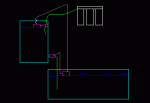Hi, I've just built my auto-top off, incorporating a timer, and wanted to chime in.
If incorporated correctly, the timer does NOT dictate the amount of water that is added over a given period - it simply dictates the amount of switching your solenoid will do.
You use a simple float switch (I used three float switches, for low/high redundancy... the low float switch is also used to shut off the sump pump in the event of a low water level), connected to relay(s) to control a solenoid, via a timer. Due to the low hysteresis of the switch, the cycling frequency was high. By adding a timer set to come on, say, every hour or two (each time for 3-5 minutes), you are simply reducing the frequency. The correct amount of water is still added due to the float switches -- even if the timer is on, water will only be topped up to the required level, and will not be topped up at all if not needed.
I believe the time idea is the best (in terms of reliability) and simplest solution.
My plans are for a top-off reservoir with pump. However, the principle is the same for a solenoid and r/o unit. You would not need a second storage tank.
I am happy to post a circuit diagram for the three switch system if it would be helpful.






